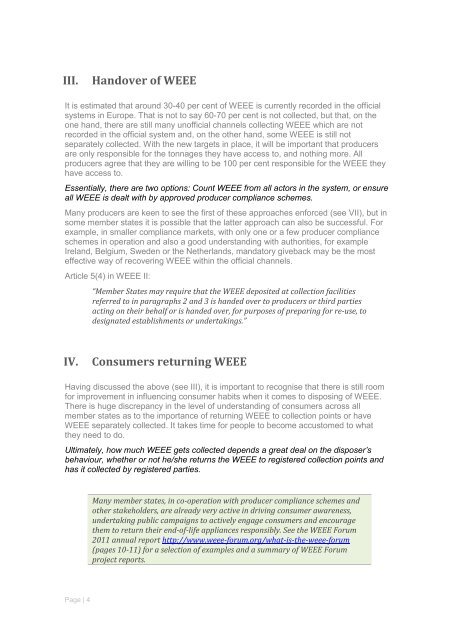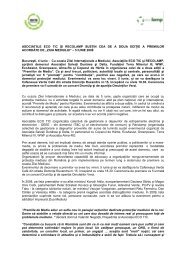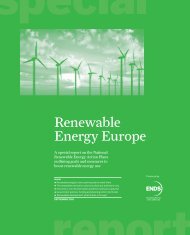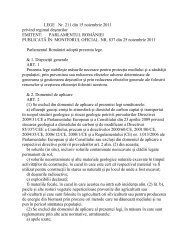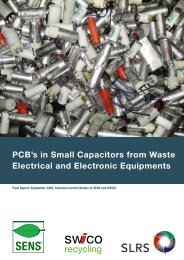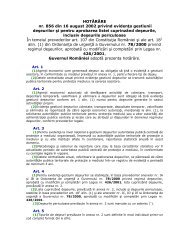The challenge of transposing WEEE II into national law - WEEE Forum
The challenge of transposing WEEE II into national law - WEEE Forum
The challenge of transposing WEEE II into national law - WEEE Forum
Create successful ePaper yourself
Turn your PDF publications into a flip-book with our unique Google optimized e-Paper software.
<strong>II</strong>I.Handover <strong>of</strong> <strong>WEEE</strong>It is estimated that around 30-40 per cent <strong>of</strong> <strong>WEEE</strong> is currently recorded in the <strong>of</strong>ficialsystems in Europe. That is not to say 60-70 per cent is not collected, but that, on theone hand, there are still many un<strong>of</strong>ficial channels collecting <strong>WEEE</strong> which are notrecorded in the <strong>of</strong>ficial system and, on the other hand, some <strong>WEEE</strong> is still notseparately collected. With the new targets in place, it will be important that producersare only responsible for the tonnages they have access to, and nothing more. Allproducers agree that they are willing to be 100 per cent responsible for the <strong>WEEE</strong> theyhave access to.Essentially, there are two options: Count <strong>WEEE</strong> from all actors in the system, or ensureall <strong>WEEE</strong> is dealt with by approved producer compliance schemes.Many producers are keen to see the first <strong>of</strong> these approaches enforced (see V<strong>II</strong>), but insome member states it is possible that the latter approach can also be successful. Forexample, in smaller compliance markets, with only one or a few producer complianceschemes in operation and also a good understanding with authorities, for exampleIreland, Belgium, Sweden or the Netherlands, mandatory giveback may be the mosteffective way <strong>of</strong> recovering <strong>WEEE</strong> within the <strong>of</strong>ficial channels.Article 5(4) in <strong>WEEE</strong> <strong>II</strong>:“Member States may require that the <strong>WEEE</strong> deposited at collection facilitiesreferred to in paragraphs 2 and 3 is handed over to producers or third partiesacting on their behalf or is handed over, for purposes <strong>of</strong> preparing for re-use, todesignated establishments or undertakings.”IV.Consumers returning <strong>WEEE</strong>Having discussed the above (see <strong>II</strong>I), it is important to recognise that there is still roomfor improvement in influencing consumer habits when it comes to disposing <strong>of</strong> <strong>WEEE</strong>.<strong>The</strong>re is huge discrepancy in the level <strong>of</strong> understanding <strong>of</strong> consumers across allmember states as to the importance <strong>of</strong> returning <strong>WEEE</strong> to collection points or have<strong>WEEE</strong> separately collected. It takes time for people to become accustomed to whatthey need to do.Ultimately, how much <strong>WEEE</strong> gets collected depends a great deal on the disposer’sbehaviour, whether or not he/she returns the <strong>WEEE</strong> to registered collection points andhas it collected by registered parties.Many member states, in co-operation with producer compliance schemes andother stakeholders, are already very active in driving consumer awareness,undertaking public campaigns to actively engage consumers and encouragethem to return their end-<strong>of</strong>-life appliances responsibly. See the <strong>WEEE</strong> <strong>Forum</strong>2011 annual report http://www.weee-forum.org/what-is-the-weee-forum(pages 10-11) for a selection <strong>of</strong> examples and a summary <strong>of</strong> <strong>WEEE</strong> <strong>Forum</strong>project reports.Page | 4


